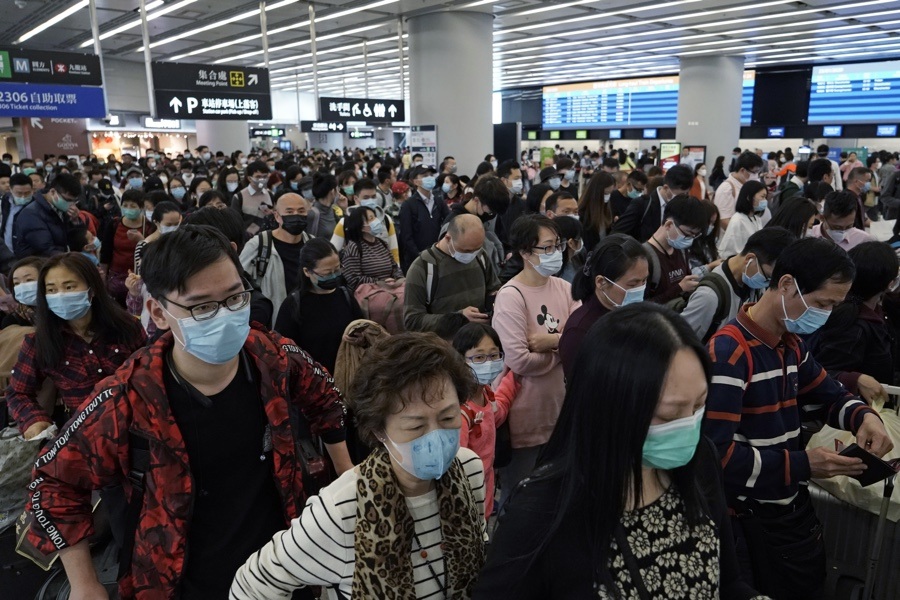Inside a Philly Firm’s Quest to Develop a Coronavirus Vaccine
With a $9 million grant, Inovio Pharmaceuticals is testing a unique immunotherapy approach that may also eventually be used to fight other viruses and cancer.

In this Thursday, Jan. 23, 2020 file photo, passengers wear protective face masks at the departure hall of the high speed train station in Hong Kong. (AP Photo/Kin Cheung, File)
The recent outbreak of a new strain of a coronavirus (2019-nCoV) in China has led to the declaration of a global health emergency by the World Health Organization (WHO) and widespread fear of a massive pandemic. In response to the scramble for a cure, the Coalition for Epidemic Preparedness Innovations (CEPI) provided Plymouth Meeting biotech company Inovio Pharmaceuticals, Inc. with a $9 million grant to use their DNA medicine platform to develop a vaccine.
Inovio is now one of many on a mission to prevent further devastation from 2019-nCoV, and the unique immunotherapy approach they’re employing to get there could be a major indicator of where medicine is headed in the future.
NextHealth PHL spoke with Dr. Joseph Kim, president and CEO of Inovio, about how DNA medicine might not only be the solution to the 2019-nCoV coronavirus, but also a pathway to future treatments of other viruses and cancer.
NextHealth PHL: What exactly is a coronavirus, and how is the new strain of 2019-nCoV different from other strains?
Kim: The coronavirus is actually a large family of viruses, most of which only infect animals. It’s not named after a beer; it is named after the halo around the virus that you see when you look at it under a microscope.
Both Middle East Respiratory Syndrome (MERS) and Severe Acute Respiratory Syndrome (SARS) are common members of the coronavirus family. This new Wuhan coronavirus, or 2019-nCoV, has gained our fear and concern mostly because this virus is able to jump from animals and infect humans. Not only that, but there’s been confirmed cases of human-to-human infection, which makes it a bigger potential threat. That’s why the WHO declared the outbreak a global health emergency.
The virus itself is highly contagious, and it’s terrible because you can be asymptomatic and still be able to spread the virus. You can look completely healthy while you’re carrying it and passing it on, so that’s a big worry and fear associated with this new strain.
What allows a virus to be able to make that jump from animals to humans?
Kim: It’s a change in the DNA of the virus and in some of the binding sites that causes them to be more amenable to things that are in human cells. Typically, these viruses aren’t infectious, and a lot of these cases of animal-based coronaviruses don’t infect humans. But this new coronavirus experienced a change that allowed it to jump to humans. And because we haven’t been exposed to this virus previously, there’s not much our immune system can do to prepare for it without a vaccine. That’s why there’s a big medical concern.
And your approach to developing this vaccine at Inovio has to do with small doses of exposure to the virus through DNA medicine? How does that work?
Kim: We have a very adaptive platform. There’s no actual linkage to the disease, because the DNA itself does not cause the human to receive the disease and its symptoms. Basically, we find a target that we want the immune system to recognize. In this case, we’re focusing on the spike protein of the coronavirus, which mediates the actual entry of the virus into cells.
Even if full development of your vaccine takes a few months, do you think that’s fast enough to make much of a difference in the outbreak?
Kim: We’re going to move as fast as we can, and hopefully faster than we have with outbreaks in the past. We’re partnering and collaborating with different agencies and companies to pump up the scale of manufacturing and distribution. But to do all of this, we also need cooperation from the proper regulatory agencies in charge of recognizing when something’s a public health emergency, and that’s already beginning to happen. The FDA and other federal agencies are definitely starting to see the potential use of this therapy and the need for moving forward with trials.
Is the immunotherapy approach you’re using for developing a coronavirus vaccine the same as your approach to developing vaccines for other viruses?
Kim: Yes, and we can even take the same approach against some forms of cancer by focusing on different targets for each. The real difference in motivation across all of the diseases we look at is in the target response. So our overall approach is identical, whether we’re developing a therapy for glioblastoma or a vaccine for this new coronavirus. Our underlying platform is identical. Our technology is identical. Our approach is identical. That’s the beauty of our DNA platform. For new viruses, old viruses, or cancerous cells, we’re able to generate immune responses for clinical benefit.
Immunotherapy looks like it might have a big place in the future of medicine, but why do you think it hasn’t taken off quite yet? If we can make effective vaccines or cancer treatments so quickly, why don’t we see that happening all the time?
Kim: I agree that this is one of the more important modern advancements for immunotherapy. And Inovio is leading the efforts for DNA medicine, just as Moderna, Inc. is for RNA medicine. I think we’ll see more of this approach to treatment on the clinical frontier in the next four or five years. Immunotherapy is just a better modern approach to treatments of viruses or cancers. It’s not a surprise we were selected to use our DNA medicine platform to work on finding a vaccine.


